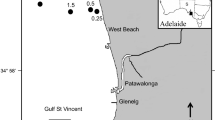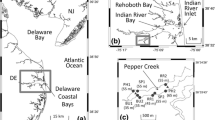Abstract
Seagrass meadows are often cited as important nursery areas for newly settled red drum even though many estuaries, such as Galveston Bay, Texas, support large numbers of red drum and have limited seagrass cover, suggesting the use of alternate nursery areas. We examined patterns of habitat use for newly settled red drum at six sampling areas in Galveston Bay; two areas had seagrass beds and four areas had no seagrass. We measured densities in different habitat types using epibenthic sleds and enclosure samplers. Peak recruitment of young red drum to the estuary occurred during September through December. Highest densities of new settlers were found in seagrass meadows (primarilyHalodule wrightii), but when seagrass was absent, the highest densities of red drum occurred along theSpartina alterniflora marsh edge interface. Densities were relatively low on nonvegetated bottom away from the marsh edge. We also examined density patterns in other habitat types at selected sampling areas and found no red drum within marsh vegetation away from the marsh edge interface (5 and 10 m into the marsh interior). Oyster reefCrassostrea virginica was sampled using lift nets, and we found no red drum using this habitat, although adjacent seagrass and marsh interface habitats were used. Even though red drum densities in marsh edge were low relative to seagrass, the large areal extent of marshes in the bay complex probably makes marsh edge the most important nursery habitat for red drum in Galveston Bay.
Similar content being viewed by others
Literature Cited
Adair, S. E., J. L. Moore, andC. P. Onuf. 1994. Distribution and status of submerged vegetation in estuaries of the upper Texas coast.Wetlands 14:110–121.
Baltz, D. M., J. W. Fleeger, C. F. Rakocinski, andJ. N. McCall. 1998. Food, density, and microhabitat: Factors affecting growth and recruitment potential of juvenile saltmarsh fishes.Environmental Biology of Fishes 53:89–103.
Baltz, D. M., D. Rakocinski, andJ. W. Fleeger. 1993. Microhabitat use by marsh-edge fishes in a Louisiana estuary.Environmental Biology of Fishes 36:109–126.
Boesch, D. F. andR. E. Turner. 1984. Dependence of fishery species on salt marshes: The role of food and refuge.Estuaries 7:460–468.
Coen, L. D., M. W. Luckenbach, and D. L. Breitburg. 1991. The role of oyster reefs as essential fish habitat: A review of current knowledge and some new perspectives, p. 438–454.In L. R. Benaka (ed.), Fish Habitat: Essential Fish Habitat and Rehabilitation. American Fisheries Society, Symposium 22, Bethesda, Maryland.
Comyns, B. H., J. Lyczkowski-Shultz, D. L. Nieland, andC. A. Wilson. 1991. Reproduction of red drum,Scianops ocellatus, in the northcentral Gulf of Mexico: Seasonality and spawner biomass. U.S. Department Commerce, National Oceanic and Atmospheric Administration Technical Report National Marine Fisheries Service 95:17–26. Silver Spring, Maryland.
Connell, S. D. andG. P. Jones. 1991. The influence of habitat complexity on postrecruitment processes in a temperature reef fish population.Journal of Experimental Marine Biology and Ecology 151:271–294.
Currin, B. M., J. P. Reed, andJ. M. Miller. 1984. Growth, production, food consumption, and mortality of juvenile spot and croaker: A comparison of tidal and nontidal nursery areas.Estuaries 7:451–459.
Cushing, D. H. 1975. Marine Ecology of Fisheries. Cambridge University Press, Cambridge, England.
Day, Jr.,J. W., C. A. S. Hall, W. M. Kemp, andA. Yanez-Arancibia. 1989. Estuarine Ecology. John Wiley and Sons, New York.
Fuls, B. E. andR. A. Hensley. 1998. Trends in relative abundance and size of selected finfishes and shell fishes along the Texas coast: November 1975-December 1996. Management Data Series 159. Texas Parks and Wildlife, Coastal Fisheries Division, Austin, Texas.
Heck, Jr.,K. L., D. A. Nadeau, andR. Thomas. 1997. The nursery role of seagrass beds.Gulf of Mexico Science 15:50–54.
Heck, Jr.,K. L. andT. A. Thoman. 1981. Experiments on predator-prey interaction in vegetated aquatic habitats.Journal of Experimental Marine Biology and Ecology 53:125–135.
Holt, S. A., C. L. Kitting, andC. R. Arnold. 1983. Distribution of young red drums among different seagrass meadows.Transactions of the American Fisheries Society 112:267–271.
Houde, E. D. 1987. Fish early life dynamics and recruitment variability. American Fisheries Society Symposium 2:17–29. Miami, Florida.
Irlandi, E. A. andM. K. Crawford. 1997. Habitat linkages: The effect of intertidal saltmarshes and adjacent subtidal habitats on abundance, movement, and growth of an estuarine fish.Oecologia 110:222–230.
Kamermans, P., K. Y. Guindon, andJ. M. Miller. 1995. Importance of food availability for growth of juvenile southern flounder (Paralichthys lethostigma) in the Pamlico River estuary, North Carolina, USA.Netherlands Journal of Sea Research 34:101–109.
Kneib, R. T. 1984. Patterns of invertebrate distribution and abundance in the intertidal salt marsh: Causes and questions.Estuaries 7:392–412.
Kneib, R. T. 1993. Growth and mortality in successive cohorts of fish larvae within an estuarine nursery.Marine Ecology Progress Series 94:115–127.
Leggett, W. C. andE. Deblois. 1994. Recruitment in marine fishes: Is it regulated by starvation and predation in the egg and larval stages?.Netherlands Journal of Sea Research 32:119–134.
Levin, P. S., R. Petrik, andJ. Malone. 1997. Interactive effects of habitat selection, food supply and predation on recruitment of an estuarine fish.Ocologia 112:55–63.
Micheli, F. andC. H. Peterson. 1999. Estuarine vegetated habitats as corridors for predator movements.Conservation Biology 13:869–881.
Minello, T. J. 1999. Nekton densities in shallow estuarine habitats of Texas and Louisiana and the identification of essential fish habitat, p. 438–454.In L. R. Benaka (ed.), Fish Habitat: Essential Fish Habitat and Rehabilitation. American Fisheries Society, Symposium 22, Bethesda, Maryland.
Minello, T. J. andJ. W. Webb, Jr. 1997. Use of natural and createdSpartina alterniflora salt marshes by fishery species and other aquatic fauna in Galveston Bay, Texas USA.Marine Ecology Progress Series 151:165–179.
Minello, T. J., R. J. Zimmerman, andR. Medina. 1994. The importance of edge for natant macrofauna in a created salt marsh.Wetlands 14:184–198.
Murphy, M. D. andR. G. Taylor. 1990. Reproduction, growth, and mortality of red drumSciaenops ocellatus in Florida waters.Fishery Bulletin 88:531–542.
Neill, W. H., J. M. Miller, H. W. Van Der Veer, andK. O. Winemiller. 1994. Ecophysiology of marine fish recruitment: A conceptual framework for understanding interannual variability.Netherlands Journal of Sea Research 32:135–152.
Orth, R. J., K. L. Heck, Jr., andJ. van Montfrans. 1984. Faunal communities in seagrass beds: A review of the influence of plant structure and prey characteristics on predator-prey relationships.Estuaries 7:339–350.
Pattillo, M. E., T. E. Czapla, D. M. Nelson, andM. E. Monaco. 1997. Distribution and abundance of fishes and invertebrates in Gulf of Mexico estuaries, Volume II: Species life history summaries. Estuarine Living Marine Resources Program Report No. 11. National Oceanic and Atmospheric Administration/National Ocean Service Strategic Environmental Assessments Division, Silver Spring, Maryland.
Perkins-Visser, E., T. G. Wolcott, andD. L. Wolcott. 1996. Nursery role of seagrass beds: Enhanced growth of juvenile blue crabs (Callinectes sapidus Rathbun).Journal of Experimental Marine Biology and Ecology 198:155–173.
Peters, K. M. andR. H. McMichael, Jr. 1987. Early life history of the red drumSciaenops ocellatus (Pisces: Sciaenidae) in Tampa Bay, Florida.Estuaries 10:92–107.
Peterson, G. W. andR. E. Turner. 1994. The value of salt marsh edge vs interior as a habitat for fish and decapod crustaceans in a Louisiana tidal marsh.Estuaries 17:235–262.
Petrik, R., P. S. Levin, G. W. Stunz, andJ. Malone. 1999. Recruitment of Atlantic croaker,Micropongias undulatus. Do postsettlement processes disrupt or reinforce initial patterns of settlement?.Fishery Bulletin 97:954–961.
Penland, S. andK. E. Ramsey. 1990. Relative sea-level rise in Louisiana and the Gulf of Mexico: 1908–1988.Journal of Coastal Research 6:323–342.
Phelan, B. A., R. Goldberg, A. J. Bejda, J. Pereira, S. Hagan, P. Clark, A. L. Studholme, A. Calabrese, andK. W. Able. 2000. Estuarine and habitat-related differences in growth rates of young-of-the-year winter flounder (Pseudopleuronectes americanus) and tautog (Tautoga onitis) in three northeastern US estuaries.Journal of Experimental Marine Biology and Ecology 147:1–28.
Pollard, D. A. 1984. A review of ecological studies on seagrass-fish communities, with particular reference to recent studies in Australia.Aquatic Botany 18:3–42.
Powell, E. N. 1993. Status and trends analysis of oyster reef habitat in Galveston Bay, p. 207–209.In R. W. Jensen (ed.), Proceeding, Second State of the Bay Symposium, Galveston, Texas. The Galveston Bay National Estuary Program, Galveston, Texas.
Rakocinski, C. F., D. M. Baltz, andJ. F. Fleeger. 1992. Correspondence between environmental gradients and the community structure of marsh-edge fishes in a Louisiana estuary.Marine Ecology Progress Series 80:135–148.
Rooker, J. R. andS. A. Holt. 1997. Utilization of subtropical seagrass meadows by newly settled red drumScianops ocellatus. Patterns of distribution and growth.Marine Ecology Progress Series 158:139–149.
Rooker, J. R., G. J. Holt, andS. A. Holt. 1998b. Vulnerability of newly settled red drum (Sciaenops ocellatus) to predatory fish: Is early-life survival enhanced by seagrass meadows?Marine Biology 131:145–151.
Rooker, J. R., S. A. Holt, M. A. Soto, andG. J. Holt. 1998a. Post-settlement patterns of habitat use by sciaenid fishes in subtropical seagrass meadows.Estuaries 21:315–324.
Rozas, L. P. 1992. Bottomless lift net for quantitatively sampling nekton on intertidal marshes.Marine Ecology Progress Series 89: 287–292.
Rozas, L. P. andT. J. Minello. 1997. Estimating densities of small fishes and decapod crustaceans in shallow estuarine habitats: A review of sampling design with focus on gear selection.Estuaries 20:199–213.
Rozas, L. P., andT. J. Minello. 1998. Nekton use of salt marsh, seagrass, and nonvegetated habitats in a south Texas (USA) estuary.Bulletin of Marine Science 63:481–501.
Rozas, L. P. andR. J. Zimmerman. 2000. Small-scale patterns of nekton use among marsh and adjacent shallow nonvegetated areas of the Galveston Bay estuary, Texas (USA).Marine Ecology Progress Series 193:217–239.
Sheridan, P., G. McMahan, K. Hammerstrom, andW. Pulich, Jr. 1998. Factors affecting restoration ofHalodule wrightii to Galveston Bay, Texas.Restoration Ecology 6:144–158.
Short, F. T. andS. Wyllie-Echeverria. 1996. Natural and human-induced disturbance of seagrasses.Environmental Conservation 23:17–27.
Sogard, S. M. 1992. Variability in growth rates of juvenile fishes in different estuarine habitats.Marine Ecology Progress Series 85: 35–53.
Sogard, S. M. andK. W. Able. 1992. Growth variation of newly settled winter flounder (Pseudopleuronectes americanus) in New Jersey estuaries as determined by otolith microstructure.Netherlands Journal of Sea Research 29:163–172.
Stunz, G. W. 1999. Causes and consequences of recruitment patterns in newly settled red drum (Sciaenops ocellatus). Ph.D. dissertation, Texas A&M University, College Station, Texas.
Stunz, G. W., P. S. Levin, andT. J. Minello. 2001. Selection of estuarine nursery habitats by wild-caught and hatchery-reared juvenile red drum in laboratory mesocosms.Environmental Biology of Fishes 61:305–313.
Stunz, G. W. andT. J. Minello. 2001. Habitat-related predation on juvenile wild-caught and hatchery-reared red drumSciaenops ocellatus (Linnaeus).Journal of Experimental Marine Biology and Ecology 260:13–25.
Summerson, H. C. andC. H. Peterson. 1984. Role of predation in organizing benthic communities of a temperate-zone seagrass bed.Marine Ecology Progress Series 15:63–77.
Thayer, G. W., P. L. Murphey, andM. W. La Croix. 1992. Responses of plant communities in western Florida Bay to die-off of seagrasses.Bulletin of Marine Science 54:718–726.
Weinstein, M. P. 1979. Shallow marsh habitats as primary nurseries for fishes and shellfish, Cape Fear River, North Carolina.Fishery Bulletin 77:339–357.
Wenner, E., H. R. Beatty, andL. Coen. 1996. A method for quantitatively sampling nekton on intertidal oyster reefs.Journal Shellfish Research 15:769–775.
White, W. A. andT. A. Tremblay. 1995. Submergence of wetlands as a result of human-induced subsidence and faulting along the upper Texas Gulf Coast.Journal of Coastal Research 11:788–807.
Zimmerman, R. J. andT. J. Minello. 1984. Fishery habitat requirements: Utilization of nursery habitats by juvenile penaeid shrimp in a Gulf of Mexico salt marsh, p. 371–383.In B. J. Copeland, K. Hart, N. Davis, and S. Friday (eds.), Research for Managing the Nation's Estuaries. UNC-SG-84-08, University of North Carolina Sea Grant Publication. Raleigh, North Carolina.
Zimmerman, R. J., T. J. Minello, T. J. Baumer, andM. C. Castiglione. 1989. Oyster reef as habitat for estuarine macrofauna. National Oceanic and Atmospheric Administration Technical Memorandum, National Marine Fisheries Service, Southeast Fisheries Science Center, Galveston, Texas.
Zimmerman, R. J., T. J. Minello, andG. Zamora. 1984. Selection of vegetated habitat by brown shrimp,Penaeus aztecus, in a Galveston Bay salt marsh.Fishery Bulletin 82:325–336.
Author information
Authors and Affiliations
Corresponding author
Rights and permissions
About this article
Cite this article
Stunz, G.W., Minello, T.J. & Levin, P.S. A comparison of early juvenile red drum densities among various habitat types in Galveston Bay, Texas. Estuaries 25, 76–85 (2002). https://doi.org/10.1007/BF02696051
Received:
Accepted:
Issue Date:
DOI: https://doi.org/10.1007/BF02696051




